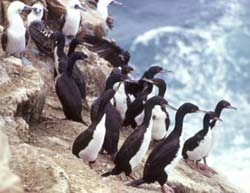Populations of Peruvian Seabirds Plummeted Due to Increased Fishing Activity, Study Says

In the late 19th and early 20th centuries, the tens of millions of marine birds living in the “Bird Islands of Peru” became famous around the world. This was due to their appeal as a visual spectacle and because they became economically important as high producers of guano, droppings that the country mined and exported around the world for fertilizer.
A new study published in the current issue of the journal Fisheries Oceanography says the populations of these famous birds have declined dramatically in the last 40 years, largely because the availability of their main food supply, anchovies, once plentiful, has been severely reduced by the Peruvian fishery.
The authors of the study are Jaime Jahncke and George Hunt of the University of California, Irvine, and David Checkley of Scripps Institution of Oceanography at the University of California, San Diego.
The results are the product of a new scientific model developed by Jahncke while studying with Checkley at Scripps Institution. The model characterizes the Peruvian marine ecosystem by cross-referencing natural factors such as wind strength with human influences through fishing activity. “We saw a very different system prior to and after fishing was increased,” said Jahncke. “This model gives us a very clear example of how physical processes in the ocean and human influences can limit the populations of these birds, changing them from one state to another.”
The Peruvian anchovy fishery, the largest single-species fishery in the world, significantly increased production in the 1950s and ’60s, exporting millions of metric tons of anchovies per year.
The study shows that wind forces in the early part of the 20th century caused a significant rise in the nutrient supply off the Peruvian coast and thereby led to a boom in the anchovy population. With more food available, the numbers of guano-producing seabirds, including cormorants, boobies and pelicans, similarly increased from 1925 to 1955.
But in the decades that followed, the seabird populations declined significantly.
“The decrease,” the authors note, “appears to be due to the depletion of their food by the fishery, which grew to catch about 85 percent of the prey otherwise available to the seabirds.”
All told, the latter half of the 20th century saw a dramatic decline-from about 20 million seabirds to about five million, according to the paper. Today, many of the so-called bird islands of Peru are largely devoid of seabirds.
“Birds are very visible manifestations of the health of an ecosystem,” said Checkley, a professor in the Integrative Oceanography Division at Scripps. “This study demonstrates how fishing can profoundly affect an ecosystem. That’s important because we are coming to a time in the United States and elsewhere in the world when people recognize that fisheries have to be managed not only based upon the dynamics of the individual populations, but on the ecosystem in which they reside. In order to do that we have to understand how fisheries affect the ecosystem and vice versa.”
The authors say their study would not have been possible without the prominent leadership and high quality of long-term scientific data provided by the Peruvian fisheries agency, called the Instituto del Mar del Peru (IMARPE). The authors are aware of IMARPE’s effort to change from single-species management to an ecosystem-based approach, and to consider a more reasonable anchovy harvest.
Checkley notes that although the fishery has profoundly impacted the abundance of these birds, a reversal is certainly possible.
“The important point is that we achieve an understanding of the causes of these population changes over time and manage them accordingly,” said Checkley. “Once we have the understanding I think it’s really important that management and policy decisions are based on that understanding.”
Note: David Checkley is editor-in-chief of Fisheries Oceanography but was not involved in the paper’s review. The paper was reviewed, accepted and coordinated by a separate editor.
Scripps Institution of Oceanography, at the University of California, San Diego, is one of the oldest, largest, and most important centers for global science research and graduate training in the world. The National Research Council has ranked Scripps first in faculty quality among oceanography programs nationwide. The scientific scope of the institution has grown since its founding in 1903 to include biological, physical, chemical, geological, geophysical, and atmospheric studies of the earth as a system. Hundreds of research programs covering a wide range of scientific areas are under way today in 65 countries. The institution has a staff of about 1,300, and annual expenditures of approximately $140 million from federal, state, and private sources. Scripps operates one of the largest U.S. academic fleets with four oceanographic research ships and one research platform for worldwide exploration.
Media Contact
More Information:
http://scrippsnews.ucsd.edu/article_detail.cfm?article_num=632All latest news from the category: Ecology, The Environment and Conservation
This complex theme deals primarily with interactions between organisms and the environmental factors that impact them, but to a greater extent between individual inanimate environmental factors.
innovations-report offers informative reports and articles on topics such as climate protection, landscape conservation, ecological systems, wildlife and nature parks and ecosystem efficiency and balance.
Newest articles

Parallel Paths: Understanding Malaria Resistance in Chimpanzees and Humans
The closest relatives of humans adapt genetically to habitats and infections Survival of the Fittest: Genetic Adaptations Uncovered in Chimpanzees Görlitz, 10.01.2025. Chimpanzees have genetic adaptations that help them survive…

You are What You Eat—Stanford Study Links Fiber to Anti-Cancer Gene Modulation
The Fiber Gap: A Growing Concern in American Diets Fiber is well known to be an important part of a healthy diet, yet less than 10% of Americans eat the minimum recommended…

Trust Your Gut—RNA-Protein Discovery for Better Immunity
HIRI researchers uncover control mechanisms of polysaccharide utilization in Bacteroides thetaiotaomicron. Researchers at the Helmholtz Institute for RNA-based Infection Research (HIRI) and the Julius-Maximilians-Universität (JMU) in Würzburg have identified a…



